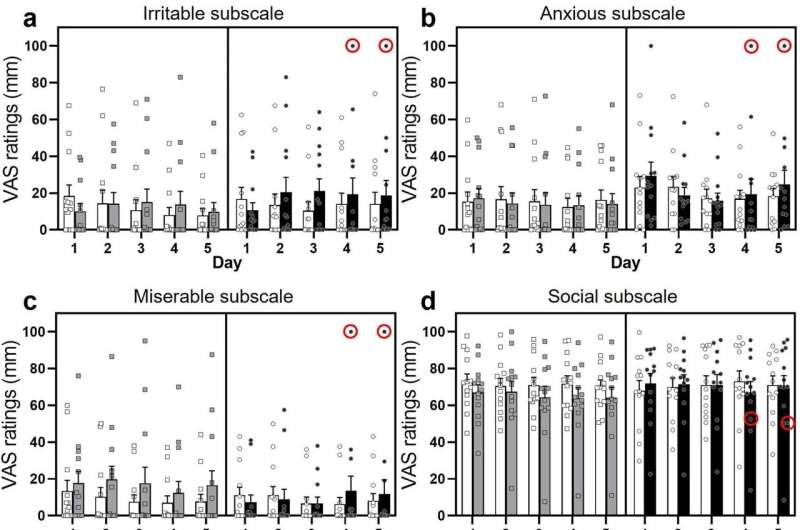This article has been reviewed according to Science X's editorial process and policies. Editors have highlighted the following attributes while ensuring the content's credibility:
fact-checked
peer-reviewed publication
trusted source
proofread
Drug to treat cannabis use disorder shows promise in clinical trial

A first-in-class drug engineered to selectively inhibit the signaling pathway of the cannabinoid receptor shows promise as a safe and effective treatment for cannabis use disorder (CUD), a condition where a person is unable to control their cannabis use, even though it's causing problems in their lives.
In a Phase 2a clinical trial, led by Columbia University Irving Medical Center and Aelis Farma, a French biopharmaceutical company, researchers found that the candidate drug, AEFO117, significantly reduced the effects of cannabis in daily cannabis smokers.
The report, "Signaling-specific inhibition of the CB1 receptor for cannabis use disorder: phase 1 and phase 2a randomized trials," was published online June 8 by the journal Nature Medicine.
AEF0117 appears to counteract the "high" associated with THC, the primary psychoactive component of cannabis, at the type 1 cannabinoid receptors—the CB1 receptors—without disrupting the receptors' physiological and behavioral functions, which include memory and learning, emotional processing, sleep, and eating behavior.
"We have tested over a dozen potential treatment medications in our Cannabis Research Laboratory, and this is the first to decrease both the positive mood effects of cannabis and the decision to use cannabis by daily smokers," said Margaret (Meg) Haney, Ph.D., supervisor of the phase I studies and principal investigator of the 2a proof-of-concept study, and a professor of neurobiology in the Department of Psychiatry at Columbia, where she is the director of the Cannabis Research Laboratory.
"Patients seek treatment when they have difficulty controlling their cannabis use despite the problems it is causing at work or in their personal lives. Our findings suggest AEF0117 has great potential for treating problematic cannabis use," added Dr. Haney, who also co-directs Columbia's Substance Use Research Center.
Cannabis use disorder on rise
As cannabis use becomes increasingly mainstream—with 38 states, three territories, and the District of Columbia legalizing the drug for medicinal and/or recreational use—consumption is on the rise, along with problematic use, which encompasses addiction.
Cannabis use disorder is an underappreciated risk of using cannabis that affects about 14 million individuals in the United States. Despite daily use of cannabis being at record high levels among adolescents and young adults, many are unaware that cannabis can be addictive.
To date, no medications have been approved by the Food and Drug Administration (FDA) for the treatment of cannabis use disorder—and evidenced-based behavioral therapies have shown limited benefits.
Culmination of a decade of research
AEF0117, developed by Aelis Farma, is the first of the new pharmacologic class, CB1-SSi, which is based on a unique mechanism of action that enables CB1-SSi to inhibit only the cellular signals involved in CUD. This breakthrough approach differs from previous CB1 receptor antagonists that, due to their broad blockade of all CB1 receptor activity, caused significant adverse effects preventing their clinical use.
This natural brain mechanism was discovered by the research group of Aelis Farma Chief Executive Officer Pier Vincenzo Piazza, MD, when he was the director of the Neurocentre Magendie of the French National Institute of Health and Medical Research (INSERM) in Bordeaux.
"The [Nature Medicine] article culminates more than a decade of research, from discovery of this natural brain mechanism to our proof-of-concept clinical trial," said Dr. Piazza. "We are delighted to contribute to the field of neuropharmacology with a class of drugs never tested in humans before."
In the Phase 2a crossover trial that involved 29 participants with CUD who received one of two different doses of AEF0117 in one 5-day phase and placebo and in another 5-day phase in randomized order, AEF0117 significantly reduced participants' self-reported ratings of cannabis-related positive mood effects, the primary outcome measure, by a mean of 38% while also reducing the use of cannabis. These reductions occurred without precipitating cannabis withdrawal, even for volunteers who smoked several grams of cannabis per day.
More information: Pier Piazza, Signaling-specific inhibition of the CB1 receptor for cannabis use disorder: phase 1 and phase 2a randomized trials, Nature Medicine (2023). DOI: 10.1038/s41591-023-02381-w. www.nature.com/articles/s41591-023-02381-w




















